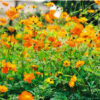**Cosmos Parviflorus: Distribution and Global Presence**

Cosmos parviflorus, also known as the small-flowered cosmos, is a charming and resilient flowering plant native to North America. With its delicate blooms and adaptability to various environments, this species has gained recognition and appreciation among botanists, horticulturists, and nature enthusiasts worldwide. In this comprehensive exploration, we delve into the distribution and global presence of Cosmos parviflorus, examining its native range, cultivation in gardens, and naturalization in diverse ecosystems across the globe.
**1. Native Range and Habitat:**
Cosmos parviflorus is indigenous to the central and southern regions of North America, where it thrives in a range of habitats, including prairies, meadows, open woodlands, and disturbed areas. This species is well-adapted to diverse soil types and growing conditions, tolerating both dry, sandy soils and moist, fertile soils with ease. In its native range, Cosmos parviflorus plays a vital role in supporting pollinators and wildlife, providing nectar, pollen, and habitat for bees, butterflies, and other beneficial insects.
**2. Cultivation and Garden Ornamental:**
Due to its attractive blooms and low-maintenance requirements, Cosmos parviflorus has become a popular garden ornamental in regions with temperate climates worldwide. Gardeners appreciate its profusion of small, daisy-like flowers and its ability to thrive in full sun to partial shade. Cultivars of Cosmos parviflorus with varying flower colors, including white, pink, and lavender, are available to suit different aesthetic preferences and garden design styles. Whether planted as a border plant, massed in flower beds, or scattered in wildflower meadows, Cosmos parviflorus adds beauty and biodiversity to garden landscapes.
**3. Naturalization and Invasive Potential:**
In addition to its cultivation as a garden ornamental, Cosmos parviflorus has naturalized in various regions outside of its native range, where it may exhibit invasive tendencies under certain conditions. Invasive populations of Cosmos parviflorus have been reported in parts of Europe, Australia, and Asia, where it can outcompete native flora and disrupt local ecosystems. Efforts to monitor and manage invasive populations of Cosmos parviflorus are essential for protecting native biodiversity and ecosystem integrity in affected areas.
**4. Ecological Role and Wildlife Habitat:**
Cosmos parviflorus plays a crucial ecological role as a nectar and pollen source for pollinators such as bees, butterflies, and moths. Its long blooming period, from late spring to early fall, provides continuous floral resources for native and migratory pollinators, supporting their health and vitality throughout the growing season. In addition to its importance for pollinators, Cosmos parviflorus serves as habitat and food source for small mammals, birds, and insect larvae, contributing to the overall biodiversity of natural ecosystems.
**5. Conservation and Restoration Efforts:**
As a native species with ecological significance, Cosmos parviflorus is a focus of conservation and restoration efforts aimed at preserving its natural habitats and promoting its role in ecosystem health. Conservation organizations, botanical gardens, and land management agencies work together to protect and restore populations of Cosmos parviflorus in its native range, conducting habitat assessments, seed collection, and reintroduction programs to enhance its conservation status and ensure its long-term survival.
**6. Global Distribution and Geographic Range:**
While native to North America, Cosmos parviflorus has been introduced and naturalized in various regions around the world, including Europe, Asia, Africa, Australia, and South America. Its adaptability to different climates and growing conditions has facilitated its spread and establishment in diverse ecosystems, where it may thrive as a garden escapee or roadside weed. The global distribution of Cosmos parviflorus highlights its resilience and capacity to colonize new habitats beyond its native range, posing both ecological challenges and opportunities for biodiversity conservation.
**7. Ethnobotanical and Cultural Significance:**
Cosmos parviflorus holds ethnobotanical and cultural significance for indigenous peoples of North America, who have utilized its flowers, leaves, and seeds for medicinal, culinary, and ceremonial purposes for centuries. Traditional uses of Cosmos parviflorus include the treatment of various ailments, such as digestive disorders, respiratory infections, and skin irritations, as well as the incorporation of its seeds into food preparations and ritual practices. By honoring the cultural heritage and traditional knowledge associated with Cosmos parviflorus, we pay tribute to the indigenous peoples who have stewarded this plant for generations.
**8. Conclusion:**
In conclusion, Cosmos parviflorus exemplifies the interconnectedness of botanical diversity and global ecosystems, showcasing the resilience and adaptability of native flora in response to changing environmental conditions. From its native range in North America to its widespread distribution across the globe, Cosmos parviflorus continues to captivate and inspire people with its beauty, ecological importance, and cultural significance. By recognizing and conserving the diversity of Cosmos parviflorus populations, we can contribute to the preservation of biodiversity and the promotion of sustainable ecosystems for future generations to enjoy and cherish.

